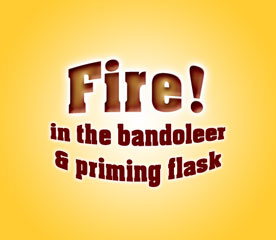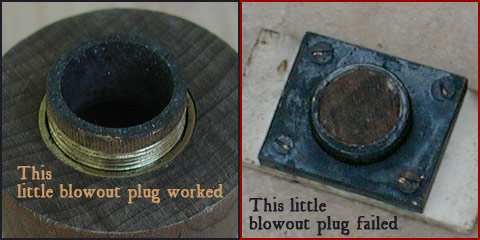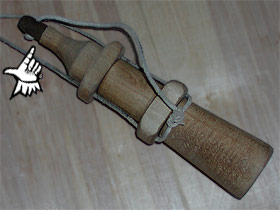
|
Have a Care!
A good musketeer takes proper care of the musket - then and now. That
degree of care should extend to the priming flask - after all, a container that
may hold enough powder to set your clothes alight or rip the skin off the palm
of your hand should be looked after.
|
Check & Keep Clean
One important care today's musketeer should provide for the priming flask is
to check it thoroughly before the event season opens, focusing on every part
that is supposed to open, then close - especially close.
At the end of the season clean the flask, especially any moving parts and
plugs. Go so far as to apply a little polish or wood treatment to the
wooden parts. A few priming flasks that have blown apart had wood so dry
that it had become brittle, almost fragile. If inspection of the wood reveals a
split, even a hairline one, seriously (seriously) consider replacing that flask
before shooting again.
Keep That Valve Clean
Some priming flasks come with push valves to allow a small amount of
powder into the spout, then to close before dispensing into the musket's pan. Such
valves are commonly brass and are designed to prevent any flash of fire from
going into the flask body from the spout. If uncared for, the slider and
its slot at the spout base can accumulate crud. That results in having to
exert extra pressure with your thumb to open the valve. Worse - far worse
- is the valve may not completely close after you release the slider, thereby
leaving an open channel from the spout into the flask body. Keep the
sliding surfaces clean, even to the point of disassembling the valve to clean.
After filling the spout with powder, release the slider, letting the spring
close the valve. By accident or intent, a few musketeers may keep the
thumb on the valve open to continue drizzling powder into the musket's pan.
Of course, this leaves open an uninterrupted route from pan into flask body.
Remain aware of all the motions of your hand when dispensing powder from spout
onto the pan; leaving the slider pushed in a bit too long is a subtle error -
the possible result will not be subtle.
Can't be Ferrous
The only part of a flask that may be made of a ferrous metal would be the
spring to hold a valve shut. Anything else metal must be of something else to
avoid creating sparks. If you have a flask with parts such as the spout
made of a ferrous metal (steel or iron), replace before using with metal parts
of brass, bronze or copper. If you persist in using parts made of ferrous
metal, consider consulting with a mental-health specialist about your
tendency for self-destruction.
Blowout Plugs
These are simple safety devices not usually seen in period priming flasks.
Today, they are commonly thin wooden disks lightly glued or simply set into the
priming flask, often in the center of the fill plug at the bottom. In brief, blowout plugs work by popping out as soon as pressure inside the
priming flask body begins to build. Popping out relieves that surging
pressure so that the priming flask does not become a grenade, only a stationary
rocket.
Right there you're beginning to realize that a blowout plug is not a
fool-proof safety catch-all. After the blowout plug does its job, the burning flask
shoots flame and copious smoke onto clothes, hands, the people next to you, etc.
This IF
the blowout plug works!
That's a serious 'IF.' The blowout plug responds to rapidly building
pressure from the igniting powder. In most situations, however, the
blowout plug is at the opposite end of the flask from where the explosion
starts, say, a spark goes into the spout at the top but the blowout plug is at
the flask's base. In between is powder that may act briefly as a cushion,
enough so that there builds enough pressure at the top of the flask to blow it
apart but not enough at the bottom to pop out the blowout plug. The progress of
the explosion and any 'cushioning' effect is over and done within milliseconds.
That, unfortunately, may be just enough time to be shot with broken shards of
flask.
Cushioning aside, some blowout plugs may fail simply because they are
fastened too firmly to the flask (or as part of the filler plug). Instead
of a rocket in your hand, you're holding an exploding grenade.
Moral of story: Do not put faith in a blowout plug to keep you and others from being
hurt.
Bottle-Like Flasks
Good news: these do not have moving parts to get dirty or to stick; they may
not even have any metal to come into contact with the pan. Bad news: once
the spout is open, there's nothing to stop a spark from reaching all the powder
in the body of the flask. Such flasks should come with a little stopper to
close the spout, which helps protect the powder when not in direct use.
More bad news: try putting that little stopper back into the spout with both
hands occupied handling the musket. Such flasks are period accurate and
dispense powder as needed. But they are more likely to suffer an accident
than a flask with a sliding valve.
Gloves
Not the heavyweight welder's (or pikeman's) gloves, but something lighter
such as leather fencer's gloves, allowing ease of finger movement and acuity of
touch sensation. And these can look 'period.' Consider using them to act
as a second skin between your hand and any flash, fire and/or explosion.
With such a second skin, your hand may only suffer bruising; without, add
first- and second-degree burns plus possible tearing.
It's Mental, Too
Apart from the physical damage to the body, kit and others, the psychological
effects of a priming flask explosion (or a bandoleer fire) can be like a hard
kick in the face. There have been those so devastated they gave up shooting
muskets altogether. Even if the blowout plug works, even if the ensuing
gush of fire does not set clothes afire, even if the hand or any other body part
is not burned or torn, even if... even if... the rest of the day is spent coming
down from the shock and surprise, easing the hyperventilation, walking off the
shakes... The rest of the event is tarnished by what just happened. You
may even have to change your breeches.
As recommended in the video on the priming flask
explosion, carry just enough
in your priming flask to shoot the loaded bottles in your bandoleer - no more!
Burning Strings & Bandoleer Fires
Today, there are more incidences of priming flask explosions than bandoleer
fires. Reviewing recent bandoleer fires, there appears to be a correlation
of multiple-bottle fires to thin, inflammable strings holding bottles to the leather straps.
One fiery bottle can quickly ignite the strings of adjacent bottles, with those
burning strings then setting off their bottles and so on. This observation
raises suspicions about bottle strings used 350 years ago: one kind of string
used then was linen waterproofed with tar (or tallow or bees wax) and most surviving examples have thin
strings. Today, consider as a safety measure using thick strings, perhaps coated
with a fire-resistant substance.
If you do not already employ this practice, put on the bandoleer last when
kitting up. Have it go over any other strapping like that for a snapsack
and the sword's baldric. Should the bandoleer begin to burn, you may have
a chance to fling it off before too much damage is done.
Black Powder Vs. Modern Stuff
All of us use replicas of firearms of centuries past. Our replicas, as with
the originals, were made for black gunpowder, only that, nothing else. So, use
of some new fangled stuff like smokeless powder only adds wild cards to an
otherwise barely predictable game. Yes, they may be classified officially
as merely "propellants" or make more noise when discharged. Nevertheless, they
open up so many more chances of something disastrously going wrong than only
black gunpowder. With black gunpowder, we may justifiably worry about the safety
of our priming flasks; with a modern substance, we add in concern for even the
strength of the musket breech.
This list is not all inclusive. Black gunpowder holds many surprises,
some of which are rude, and all are sudden. Common sense and caution go a long way to make
sure you drive home from an event with a fond smile of remembrance but no scars.
Back to the videos
Return to main menu


